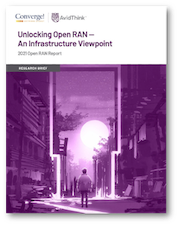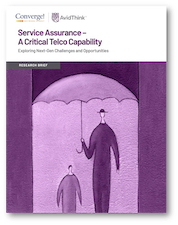Wishing you a Happy New Year! We hope 2022 brings you every success.
December was a quiet month for us, with exception providing an analyst perspective at EdgeHog Day, organized by Ori Industries, and our trip to Paris for the hybrid Upperside SD-WAN and SASE 2021. Upperside Conferences did a good job blending the virtual and physical, with speakers and attendees both online and in person. For example, when moderating a debate, I was able to easily transition between online panelists and those on stage — the conversation flow was seamless. Kudos to the Upperside team! The show was undoubtedly impacted by the ongoing pandemic, omicron variant, and lockdowns, and we sincerely hope 2022 tech conferences bounce back.
We will be watching closely to see if MWC Barcelona 2022 will face similar withdrawals to CES. We’re currently planning to be onsite and hope to see you there!
Resource Sites — 2022 Predictions!
With our partner, Converge! Network Digest, we’re launching a predictions series for 2022. Starting next week, you’ll see a host of video predictions from thought leaders in networking, cloud, and telecommunications — CEOs, CTOs, CIOs, EVPs, SVPs, VPs, architects, principal engineers, subject matter experts. Stay tuned for the premier of that on nextgeninfra.io! We’ll be promoting on social media, and via email.
In the meantime, check out our latest resource sites:
- Open RAN — You don’t want to miss Cristina Rodriguez from Intel, DISH’s Marc Rouanne, Tareq Amin from Rakuten, Shamik Mishra from Capgemini, HPE, Wind River, VMware, LFN, IBM and so much more, so give the site a visit!
- Private Mobile Networks — Featuring exclusive content from Boingo, Orange Business Services, Qualcomm, Linux Foundation, Accedian, Aarna Networks, Aruba/HPE, Fortinet, EdgeQ.
- Service Assurance — Featuring unique content from AT&T, BT, Comcast Business, Ribbon, Emblasoft, Juniper Networks, Cisco/ThousandEyes, Amartus, and Prosimo.
- SD-WAN and SASE (Updated for 2021) — Recently refreshed, so check it out!
Please contact us at [email protected] if you are interested in participating or sponsoring those in the future.
On to our news summary for December!
5G
3GPP approves 5G standard Release 18
The 3GPP approved Release 18 of the 5G standard, which is often referred to as 5G Advanced. This standard includes improvements to integrated access backhaul (IAB) and multiple input multiple output (MIMO) technology and serves as a stepping stone to 6G. Other key areas of focus for Release 18 include energy savings and XR improvements to the radio as well as using artificial intelligence and machine learning to improve the network and the air interface.
GSA says 189 operators have deployed 5G
The Global mobile Suppliers Association (GSA) says that 189 operators in 74 countries or territories have launched one or more 3GPP-compliant 5G services and 481 operators have made investments in 5G. This is a 40% increase from the end of 2020 when 135 operators had launched 5G services. The GSA also said that 47 operators have deployed 5G standalone (5G SA) networks.
EU will steer more than $1B to 5G and the cloud
The European Commission said it plans to provide more $1.13 billion to boost connectivity throughout the European Union and some of that will go toward improving 5G infrastructure and 5G coverage. It will also be used for upgrading the transport and backbone networks and strengthening cloud infrastructure.
Research firm tests Dish’s 5G network in Las Vegas
Signals Research Group (SRG) conducted what is believed to be the first independent tests of Dish Network’s 5G network in Las Vegas. Dish’s 5G network is currently in beta test mode and is expected to launch in early 2022. SRG’s tests found that Dish’s 5G network isn’t providing speeds as fast as T-Mobile’s 5G network but the company acknowledged that Dish may still be improving its network. SRG also estimates that Dish is operating about 100 cell towers in Las Vegas.
Edge
Verizon adds Google Cloud to its edge offering
Verizon is adding Google Distributed Cloud Edge to its 5G Edge platform making it possible to bring Google’s compute and storage services to the edge of the local network. Verizon previously announced similar arrangements with Amazon Web Services (AWS) and Microsoft. By adding cloud compute and storage to its 5G Edge platform Verizon is able to offer enterprises support for applications that require high bandwidth and low latency such as factory automation and autonomous robots.
Security, customer experience will be key edge computing trends in 2022
Analyst expect edge computing adoption to grow dramatically in 2022 and they predict that customer experience and security will play a key role in that growth. Lower latency will allow enterprises to process and transmit data more quickly making the customer experience much better. Potential cybersecurity threats can also be thwarted by using edge computing because data is more distributed and not stored in one hub making it harder to access.
SD-WAN
MEF updates its SD-WAN standard
The MEF updated its SD-WAN standard adding new capabilities for underlay connectivity and application performance and updating the security protocols. The updated standard, MEF 70.1, includes new metrics for application performance within and across multiple service provider networks and supports the MEF 88 application-based security protocol.
Verizon exec says it’s not easy to find the right SASE product
Although many companies tout their Secure Access Service Edge (SASE) products, Vincent Lee, director of the Secure Network as a Service for Verizon Business, told Light Reading that the company has not found a single SASE vendor solution that meets its enterprise customers’ needs. Lee said that while Verizon is looking for an easy SASE solution, it has instead had to cull together a SASE offering that combines products from a variety of vendors and includes the company’s own software solution.
Aryaka launches a new SASE and SD-WAN offering based on L3 core
Aryaka is hoping to attract new customers in new vertical markets with a new SD-WAN offering combined with a secure access service edge (SASE) product. Both are based on a new layer 3 (L3) architecture that is connected to the same points of presence as its original layer 2 private core and is similarly meshed. However, the new L3 offering is intended for non-mission critical applications and therefore costs less.
Cato adds new capabilities to its SASE platform
Cato Networks made a few tweaks to its cloud-based secured access service edge (SASE) platform that are intended to make it easier for network administrators to use the platform. The company redesigned the user interface to include a topology page that provides users with high-level insight into their deployment so they can see how many users are connected. The UI can be customized so that different network administrators can focus on any critical area of the network. The company also created a new Cloud Apps catalog that profiles more than 5,000 applications.
Windstream is helping SD-WAN customers better analyze their data
Windstream Enterprise added some new capabilities to its managed SD-WAN platform that will help enterprise customers better analyze their SD-WAN deployment data. The company added Sites Digest and Device Digest to its WE Connect Insight Engine for managed SD-WAN with Fortinet customers. The Sites Digest provides insight into bandwidth spikes and let the user know which locations are offline and which sites have high throughput, latency, jitter or packet loss. In addition, the Device Digest tells the company which devices and applications are using the most bandwidth across the network.
Lumen launches on-prem Edge Gateway
Lumen Technologies debuted a new on-premise uCPE, the Lumen Edge Gateway, that delivers virtualized services and improves the management of IT applications. The new Edge Gateway is targeted at customers that want a more managed approach to SD-WAN. The uCPE integrates with virtualized services from vendors including Versa Networks, Palo Alto Networks, Silver Peak, Fortinet, VMware, Cisco, Netscout, Audio Codes, Ribbon, CentOS, Ubuntu, RedHat and Windows Server.
SD-WAN expected to grow dramatically by 2025
During the early days of the Covid-19 pandemic deployments of SD-WAN slowed. But as businesses bounce back in the post-pandemic era, SD-WAN is experiencing a growth surge. According to some sources, SD-WAN is expected to grow from $1.9 billion in 2020 to a staggering $8.4 billion by 2025; that’s a CAGR of 34.5% and the strongest indication yet that SD-WAN solutions are most certainly central to strategies for post-pandemic success.
Dell’Oro: SD-WAN sales increased 45% year-over-year in 3Q 2021
According to Dell’Oro Group’s third quarter 2021 SD-WAN report, sales of SD-WAN solutions increased 45% year-over-year and some of that is attributed to the fact that it wasn’t as impacted by supply chain issues like some hardware solutions. Cisco is the market segment’s revenue leader, followed by Fortinet and VMware. Dell’Oro said Cisco’s quarterly SD-WAN revenue nearly doubled in the third quarter and the company experienced strong growth in North America.
SDN/NFV
STL rolls out open programmable fiber solution
STL is hoping to capitalize on the growing demand for fiber by rolling out a new open programmable fiber-to-the-X solution that disaggregates the software layer of the network allowing operators to control the subscriber management and network flows. This allows for a more scalable network. STL’s solution is compliant with the Open Networking Foundation and the Broadband Forum standards. It can be deployed on telco servers on-prem or in the cloud.
Open RAN
UK security agency joins O-RAN Alliance
The UK’s National Cyber Security Centre has joined the O-RAN Alliance, making it the first major government security agency to join the group. The move signals the importance the UK authorities are putting on open RAN, which is designed to support interoperability between vendors of mobile network products.
BT officials confirm operator is testing open RAN
BT officials are still cautious about open RAN technology but say it’s still early in the technology’s development. Company officials told Light Reading that the operator is involved in a research project that looks at open RAN capabilities and is working closely with the Telecom Infra Project (TIP) to test open RAN in East Anglia, near its London headquarters.
NTT DoCoMo may be an Open RAN leader
Although greenfield operator Rakuten is very vocal about its open RAN technology, NTT DoCoMo may actually have the most extensive open RAN deployment in its network. The operator said that its RAN is multivendor interoperable and that it uses different vendors’ equipment for the central unit/distributed unit side and the radio unit side. The company also says it has more the 10,000 base stations deployed.
AT&T and Verizon hosted Open RAN plugfests in 2021
AT&T and Verizon may not talk often about Open RAN technology but both operators have been involved in plugfests. In October and November both operators hosted open RAN plugfests in conjunction with the O-RAN Alliance, the Telecom Infra Project (TIP) and the Linux Foundation as well as vendors and academics. The plugfests took place in New Brunswick, New Jersey, along with Rutgers University; in Menlo Park, California, at the TIP Community Lab at Facebook; and in Salt Lake City at the University of Utah.
Lockheed Martin will use Radisys’ open RAN software
Lockheed Martin will use 5G open RAN software from Radisys to support its 5G base stations that are used in military tactical networks. The company said that the open RAN software will be integrated into Lockheed Martin’s 5G.MIL products, which are used to leverage commercial 5G technology and integrate it into interoperable networks used by the military.
Cloud
T-Mobile not keen on using the offloading network to the cloud
T-Mobile’s President of Networks Neville Ray told investors that he isn’t ready to offload his company’s network operators to a third-party cloud provider. Ray’s comments are noteworthy because both Dish Network and AT&T have said they will use cloud providers to run their core networks. Dish is building a nationwide 5G network and plans to run its core network on Amazon Web Services cloud. AT&T, meanwhile, is transitioning its 5G core network operations to Microsoft Azure’s cloud.
VMware says Tanzu cloud-native container platform is a priority
VMware CEO Raghu Raghuram said that strengthening the company’s Tanzu Kubernetes-based cloud-native container platform is a priority for the company as it positions itself as a multi-cloud enabler. Raghuram said that VMware is focusing on Tanzu because it is necessary for application modernization. In addition, VMware is working closely with all major cloud providers to transform into a software-as-a-service provider.
Private Networks
Enterprises want 5G private networks
According to a survey by research firm Omdia, more than 90% of enterprises that want to deploy a private network in the next two years are considering 5G as the main technology. But Omdia analysts warn that this may not be positive news for service providers because expectations for 5G are high and they will have to deliver on those expectations.
Verizon CEO is not worried about AWS’s private 5G
Verizon CEO Hans Vestberg told investors that his company isn’t concerned about Amazon Web Services’ announcement of a private 5G offering for enterprises. In fact, Vestberg said he doesn’t believe the AWS product will compete with Verizon’s private 5G platform and he characterized AWS private 5G as “an add-on” and said that Verizon could even partner with AWS on it.
AT&T CEO downplays AWS Private 5G
AT&T CEO John Stankey told investors that he doesn’t see Amazon Web Services Private 5G offering as a concern to the company and described AWS Private 5G as a “down market” offering that would be suitable for businesses that don’t have multiple locations and aren’t concerned about devices that would leave the four walls of the building.
Nokia tops list of private network providers
Juniper Research put together a competitor leaderboard for the private networks vendor sector and named Nokia as the leader with more than 380 private network customers. Ericsson came in second place followed by Druid Software, Telit and Celona.
And that’s it for December of last year!
Start the year off right by checking out content on our recent Open RAN site, along with Private Mobile Networks, Service Assurance, and our SD-WAN and SASE Refresh resource sites.
We at AvidThink would like to thank you for your support and readership in 2021 and may 2022 bring you and your loved ones much joy and success. Stay healthy and stay safe!







